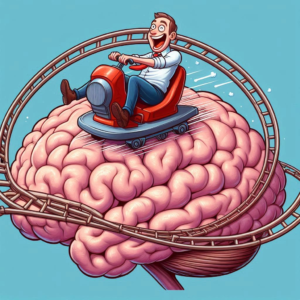
Hey there, mental gymnasts and brain-flexing enthusiasts! Welcome to the ultimate showdown between the Growth Mindset and the Fixed Mindset. Buckle up, because we’re about to take a wild ride through the twists and turns of your gray matter. By the end of this post, you’ll either be ready to conquer the world or convince yourself that your brain is as changeable as a rock. (Spoiler alert: it’s not.)
The Great Brain Battle: Growth vs. Fixed
Picture this: your brain is a wrestling ring, and in one corner, we have the heavyweight champion, the Growth Mindset, flexing its neural muscles and ready to take on any challenge. In the other corner, looking a bit stiff and uncomfortable, is the Fixed Mindset, clutching onto its “This is just how I am” trophy for dear life.
What’s the Deal with These Mindsets Anyway?
Let’s break it down for you, because who doesn’t love a good breakdown? (Except maybe your therapist.)
The Fixed Mindset: The “Eh, Why Bother?” Approach
The Fixed Mindset is like that one friend who refuses to try new restaurants because “the food might be weird.” It’s the voice in your head that says:
- “I’m not good at math, and that’s just how it is.”
- “Talent is something you’re born with, like blue eyes or an inexplicable love for pineapple on pizza.”
- “Failure? Oh no, we don’t do that here. It’s success or nothing, baby!”
Basically, the Fixed Mindset is the ultimate party pooper at the celebration of human potential.
The Growth Mindset: The “Challenge Accepted!” Attitude
Now, the Growth Mindset? This bad boy is like that overenthusiastic gym buddy who’s always trying to get you to do “just one more rep.” It’s the little engine that could, on steroids (but like, the legal, brain-enhancing kind). The Growth Mindset says:
- “I’m not good at math… yet!”
- “Talent is great, but have you heard of this cool thing called practice?”
- “Failure? More like a spicy learning opportunity!”
It’s the mindset equivalent of a motivational poster, but less cheesy and more sciency.
The Science Behind the Madness: Neuroplasticity (Because Big Words Make Us Sound Smart)

Alright, let’s get our nerd on for a hot minute. Neuroplasticity is the brain’s ability to reorganize itself by forming new neural connections. In simpler terms, it’s your brain’s way of saying, “New phone, who dis?” to old habits and learning patterns.
Your Brain: The Play-Doh of Adulthood
Remember Play-Doh? That colorful, squishy stuff that you could mold into anything (and that your parents hated because it got stuck in the carpet)? Well, surprise! Your brain is kinda like that, minus the weird smell and choking hazard warnings.
Neuroplasticity means your brain is constantly changing, adapting, and rewiring itself based on your experiences, thoughts, and actions. It’s like your brain is hosting its own home renovation show, 24/7.
Fixed Mindset: The Brain’s Couch Potato
The Fixed Mindset looks at neuroplasticity and says, “Nah, I’m good.” It’s like having a superpower and using it to… do absolutely nothing. People with a Fixed Mindset tend to:
- Avoid challenges like they’re avoiding spoilers for their favorite TV show.
- Give up faster than a New Year’s resolution in February.
- See effort as pointless, kind of like trying to reason with a cat.
- Ignore useful feedback, because who needs personal growth anyway?
Growth Mindset: The Brain’s Gym Enthusiast
On the flip side, the Growth Mindset looks at neuroplasticity and says, “Hold my protein shake.” These mental athletes:
- Embrace challenges like they’re warm, buttery hugs.
- Persist in the face of setbacks, like a dog trying to catch its tail (but with more success).
- See effort as the path to mastery, not just a way to justify eating that extra slice of pizza.
- Learn from criticism, even if it stings more than an unsolicited comment about your new haircut.
The Great Mindset Shift: From “I Can’t” to “I Can’t… Yet”

Now that we’ve established that your brain is basically a mental gymnasium, let’s talk about how to shift from a Fixed Mindset to a Growth Mindset. Spoiler alert: it doesn’t involve any actual gymnastics (unless you want it to, in which case, please record and send us the video).
Step 1: Embrace the Power of “Yet”
The word “yet” is like a tiny superhero cape for your sentences. It transforms “I can’t do this” into “I can’t do this… yet.” It’s the linguistic equivalent of leaving the door open instead of slamming it in opportunity’s face.
Try it out:
- “I’m not good at public speaking… yet.”
- “I don’t understand quantum physics… yet.”
- “I can’t resist the siren call of procrastination… yet.”
See? Suddenly, everything feels more achievable. It’s like magic, but backed by science!
Step 2: Reframe Failure as a Fancy Learning Opportunity
Failure isn’t the end; it’s more like an unexpected plot twist in the story of your success. Instead of seeing failure as a sign to give up, treat it like a very enthusiastic (if somewhat misguided) GPS recalculating your route to awesomeness.
When you fail, ask yourself:
- “What can I learn from this?”
- “How can I do better next time?”
- “Is it too soon to add this to my future bestselling memoir?”
Remember, every successful person you admire has a blooper reel longer than a CVS receipt. They just don’t usually show it on Instagram.
Step 3: Celebrate Effort, Not Just Results
In the world of Growth Mindset, effort is the new black. It’s always in style, goes with everything, and makes you look good even when you’re just trying to figure out how to adult.
Start praising yourself for:
- The hours you put in, not just the outcome
- The risks you took, even if they didn’t pan out
- The fact that you showed up, even when your bed was singing sweet songs of procrastination
It’s like giving yourself a participation trophy, but one that actually means something.
The Mindset Makeover: Practical Tips for Embracing Growth

Alright, future brain-sculpting Michelangelos, let’s get down to the nitty-gritty. Here are some practical tips to shift your mindset from fixed to growth faster than you can say “neuroplasticity” (which, let’s be honest, is not that fast for most of us).
1. The “What Would [Insert Role Model] Do?” Game
Choose someone you admire – could be Elon Musk, Michelle Obama, or even your overachieving neighbor who somehow manages to bake cookies while running a marathon. When faced with a challenge, ask yourself what they would do.
Warning: This does not work with fictional characters. Trust me, asking “What would Batman do?” rarely leads to productive real-world solutions.
2. The Five-Second Rule (Not the Food One)
When you catch yourself in a fixed mindset thought, give yourself five seconds to challenge it. It’s like the “five-second rule” for dropped food, but instead of potentially ingesting floor bacteria, you’re ingesting positivity. Yum!
Fixed thought: “I’m terrible at math.” Growth challenge: “I’m still learning math, and each problem I solve makes me better.”
3. The Failure Scrapbook
Start collecting your failures like they’re rare Pokémon cards. Keep a journal, a folder, or even a glitter-covered scrapbook of all your magnificent mess-ups. Each entry should include:
- What went wrong
- What you learned
- A hilarious gif that captures your reaction
Not only will this help you see failure as a stepping stone, but it’ll also give you great material for future TED Talks or awkward family dinners.
4. The “Not Yet” Jar
Every time you catch yourself or someone else using fixed mindset language, put a dollar in the “Not Yet” jar. Use the accumulated funds for something that promotes growth – a course, a book, or a very large coffee to fuel your late-night learning sessions.
Bonus: This works great for kids too. Watch them magically develop a growth mindset when there’s money involved!
5. The Skill-of-the-Month Club
Challenge yourself to learn one new skill each month, no matter how small. It could be juggling, speaking a new language, or finally figuring out how to fold a fitted sheet (if you master this one, please teach the rest of us).
The point is to constantly remind your brain that it can, in fact, learn new tricks, no matter how old of a dog you think you are.
The Growth Mindset in Action: Real-Life Success Stories

Now, I know what you’re thinking: “This all sounds great in theory, but does it actually work in the real world where my boss is a tyrant and my cat judges me constantly?” Well, let me hit you with some real-life examples faster than you can say “anecdotal evidence.”
The J.K. Rowling Effect
Before she became the queen of the wizarding world, J.K. Rowling was a struggling single mom who got rejected by 12 different publishers. But did she give up? Nope. She kept on believing in her story about a boy wizard, probably muttering “Expecto successful manuscript!” under her breath.
Lesson learned: Persistence pays off, and sometimes, your biggest success is hiding behind a pile of rejections.
The Colonel Sanders Spicy Growth Mindset
Colonel Sanders, the face of KFC, didn’t start his fried chicken empire until he was 62 years old. Before that, he got rejected 1,009 times trying to sell his chicken recipe. That’s a lot of “No thank you, your chicken is not my cup of tea (or bucket of chicken).”
Lesson learned: It’s never too late to start, and sometimes you need to get rejected more times than there are herbs and spices in your secret recipe before you succeed.
The Beatles’ Magical Mindset Tour
Before they became the fab four that took over the world, The Beatles were rejected by Decca Recording Studios, who said, “guitar groups are on the way out” and “The Beatles have no future in show business.” Oops.
Lesson learned: Sometimes, the experts are wrong, and your growth mindset needs to be louder than your critics.
The Dark Side of the Growth Mindset: When Positive Thinking Goes Rogue
Now, before you go all in on the growth mindset and start thinking you can become the next Einstein-Beyoncé hybrid just by believing in yourself, let’s pump the brakes for a hot second. Like anything powerful, the growth mindset can be used for evil. Okay, maybe not evil, but definitely misguided.
The Toxic Positivity Trap
There’s a fine line between having a growth mindset and being annoyingly positive. If you find yourself saying things like, “Yay! I got fired! What a great opportunity for growth!” you might have crossed that line. It’s okay to acknowledge that some things just suck.
The Burnout Express
Remember, the growth mindset is about believing you can improve, not about running yourself into the ground. If you’re staying up until 3 AM every night trying to learn quantum physics, speak fluent Klingon, and master the art of soufflé making all at once, you might be taking things too far.
The Comparison Game
Just because you believe you can grow and improve doesn’t mean you need to become better than everyone else at everything. The growth mindset is about competing with yourself, not turning life into a never-ending episode of “Who Wants to Be a Superhuman?”
In Conclusion: Your Brain, Your Rules
So, there you have it, folks – the epic saga of Growth Mindset vs. Fixed Mindset. Remember, your brain is like a Transformer, constantly able to change and adapt. (Just don’t try to actually transform it into a car. That won’t end well.)
Whether you choose to embrace the growth mindset or stick with the fixed mindset is up to you. But consider this: one of these mindsets leads to continuous improvement, exciting challenges, and the ability to annoy your fixed mindset friends with your constant enthusiasm. The other… well, it’s comfortable, I guess?
So, what’s it going to be? Are you ready to flex those mental muscles and embark on a journey of never-ending growth? Or are you content believing that your potential is as fixed as your grandma’s Jell-O mold recipe?
The choice is yours. But remember, as you ponder this life-changing decision: somewhere out there, there’s a grandma who decided it’s never too late to learn parkour. What’s your excuse?
Now go forth and grow, you magnificent, neuroplastic wonder! Your brain will thank you. Eventually. Once it’s done complaining about all the new challenges you’re throwing at it.
